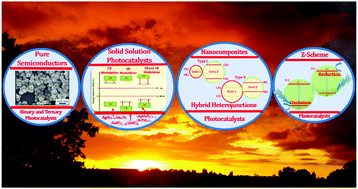当前位置:
X-MOL 学术
›
Chem. Soc. Rev.
›
论文详情
Our official English website, www.x-mol.net, welcomes your
feedback! (Note: you will need to create a separate account there.)
Nanostructured materials for photocatalysis
Chemical Society Reviews ( IF 40.4 ) Pub Date : 2019-06-07 00:00:00 , DOI: 10.1039/c9cs00102f Chunping Xu 1, 2, 3, 4 , Prasaanth Ravi Anusuyadevi 5, 6, 7, 8, 9 , Cyril Aymonier 5, 6, 7, 8, 9 , Rafael Luque 10, 11, 12, 13, 14 , Samuel Marre 5, 6, 7, 8, 9
Chemical Society Reviews ( IF 40.4 ) Pub Date : 2019-06-07 00:00:00 , DOI: 10.1039/c9cs00102f Chunping Xu 1, 2, 3, 4 , Prasaanth Ravi Anusuyadevi 5, 6, 7, 8, 9 , Cyril Aymonier 5, 6, 7, 8, 9 , Rafael Luque 10, 11, 12, 13, 14 , Samuel Marre 5, 6, 7, 8, 9
Affiliation

|
Photocatalysis is a green technology which converts abundantly available photonic energy into useful chemical energy. With a rapid rise of flow photoreactors in the last decade, the design and development of novel semiconductor photocatalysts is happening at a blistering rate. Currently, developed synthetic approaches have allowed the design of diverse modified/unmodified semiconductor materials exhibiting enhanced performances in heterogeneous photocatalysis. In this review, we have classified the so far reported highly efficient modified/unmodified semiconductor photocatalysts into four different categories based on the elemental composition, band gap engineering and charge carrier migration mechanism in composite photocatalysts. The recent synthetic developments are reported for each novel semiconductor photocatalyst within the four different categories, namely: pure semiconductors, solid solutions, type-II heterojunction nanocomposites and Z-scheme. The motivation behind the synthetic upgrading of modified/unmodified (pure) semiconductor photocatalysts along with their particular photochemical applications and photoreactor systems have been thoroughly reviewed.
中文翻译:

用于光催化的纳米结构材料
光催化是一种绿色技术,可将大量可用的光子能量转换为有用的化学能。在过去的十年中,随着流动光反应器的快速增长,新型半导体光催化剂的设计和开发正以惊人的速度发生。当前,开发的合成方法已经允许设计在异质光催化中表现出增强的性能的多种改性/未改性的半导体材料。在这篇综述中,我们基于复合光催化剂中的元素组成,带隙工程和电荷载流子迁移机理,将迄今报道的高效改性/未改性半导体光催化剂分为四类。据报道,每种新型半导体光催化剂在四个不同类别中的最新合成进展是:纯半导体,固溶体,II型异质结纳米复合材料和Z方案。彻底审查了改性/未改性(纯)半导体光催化剂的合成升级背后的动机,以及其特殊的光化学应用和光反应器系统。
更新日期:2019-06-07
中文翻译:

用于光催化的纳米结构材料
光催化是一种绿色技术,可将大量可用的光子能量转换为有用的化学能。在过去的十年中,随着流动光反应器的快速增长,新型半导体光催化剂的设计和开发正以惊人的速度发生。当前,开发的合成方法已经允许设计在异质光催化中表现出增强的性能的多种改性/未改性的半导体材料。在这篇综述中,我们基于复合光催化剂中的元素组成,带隙工程和电荷载流子迁移机理,将迄今报道的高效改性/未改性半导体光催化剂分为四类。据报道,每种新型半导体光催化剂在四个不同类别中的最新合成进展是:纯半导体,固溶体,II型异质结纳米复合材料和Z方案。彻底审查了改性/未改性(纯)半导体光催化剂的合成升级背后的动机,以及其特殊的光化学应用和光反应器系统。

















































 京公网安备 11010802027423号
京公网安备 11010802027423号